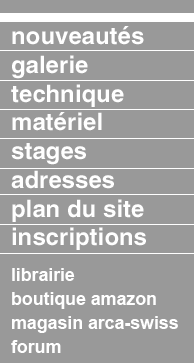

[abonnement gratuit]
the author
|
Emmanuel Bigler is a professor (now
retired) in optics and microtechnology at ENSMM, Besançon, France, an
engineering college (École Nationale Supérieure d'Ingénieurs) in
mechanical engineering and microtechnology.
He got
his Ph.D. degree from Institut d'Optique, Orsay (France).
E. Bigler
uses an Arca-Swiss 6X9 FC view camera.
Mail

|
en français
The articles
digital sensitometry (part 1)
digital
sensitometry (part 2)
|
|
Digital sensitometry,
a 3-part article
Introduction by Emmanuel Bigler
Digital image capture with silicon detectors has been widely used for
scientific applications in the last 20 years, but it is only since the
end of the 1990's that photographers have started to know and use
digital image sensors. At a first glance, photographers were not happy
with mediocre results in terms of very limited resolution (not enough
pixels in the image) and they did not realise at first the considerable
improvement of silicon detectors over film in terms of noise, low
light-level sensitivity, linearity, colour management and contrast
control. In other words, the limited available number of pixels in
digital sensors offered around year 2000 (with the exception of scanning
large format backs, for static objects only) when compared to any image
recorded on film, has prevented photographers to recognise immediately
the true revolution of silicon image detectors. This era is now over.
In this series of 3 articles, Henri Gaud will start by what was clearly
overlooked by photographers, namely photometric characteristic curves
and contrast and ISO sensitivity management issues in a silicon image
detector associated with a camera-level proprietary software. In a
second article, Henri Gaud will examine on real images different
possibilities offered by various ISO settings in the field followed
various different post-processing in the "digital darkroom". It will be
shown how digital sensors bring an incredible improvement over film in
terms of dynamic range and image noise. In a last article comparative
image resolution tests will presented, the competitors being the Canon 1
Ds MkII, a 6x8cm film camera and a 4"x5" view camera.
Preliminary Technical Note
In these articles, a full-frame 24x36mm sensor (Canon 1 Ds Mk II
digital SLR camera) was tested in combination with its proprietary
software delivering RAW format images. The only data to which the
photographer has access is this RAW file which is already the result of
some internal computing, no access to the physical sensor level is
allowed.
What is actually stored inside a RAW image is actually unknown since
those format are proprietary and not publicly disclosed. Very probably,
RAW imaga data are very close to the physical level of the sensor
output, which is linear versus the number of incident photons per second
and per unit area or per pixel in a wide range of incident brigthness.
However, as soon as the RAW format is converted to be post-processed,
data are expressed in a non linear scale (power law) and no longer a
linear scale vs incident brightness. It is interesting to represent
those post-processed image levels exactly like characteristic curves of
a film (traditionnally in a log-log scale), not that we need some
nostalgic reference to the optical densities of a black and white film,
but simply because the human eyes requires a non linear scale in the
image so that grey levels look properly spaced and balanced.
In the first article, separate RVB colour management will not be taken
into account, only the global brightness level will be considered
exactly like with a black and white panchromatic film. In reality, the
real output signal, the physical signal on output of a silicon
photodetector, is a number of photo-electrons per second for a given
input incident photon flux. In this input/output model, a silicon
photodetector is perfectly linear in a range of 1:10000 between the
weakest photon flux and the brightest one. Taking this into account it
is hard to understand at a first glance why a non linear scale would be
needed if the sensor is so extraordinary linear. In fact the human eye
is mostly sensitive to the logarithm of the number of incident photons,
so digital image post-processors actually compute a non linear power-law
scale derived from the number of output photoelectrons.
Doing so, the comparison with classical film is much easier,
photographers who are used to think in terms of optical densities on
output and f-stop scales in input will feel at home with their familiar
sensitometric curves. The goal of the article is to show that anything
valid and well-known for film-based sensitometry can be immediately
adapted to a silicon image sensor, with actual results that would have
appeared incredible to photographers only five years ago : silicon goes
far beyond what is known of film limits in terms of noise, sensitivity
and contrast management.
A millimetre-size conventional photodetector operating in analog mode
with a continuous input photon flux (this is not exactly the case with
CCD image sensors where charges are trapped in a CCD register behind the
photo cell) has a dynamic range of 1:10000, equivalent to 13 f-stops. A
dynamic range of 1:1000 is equivalent to 10 f-stops, corresponding to
the 10 or 11 black-to-white zones of Ansel Adams' Zone System (in fact a
1:1000 ratio corresponds to 11 zones ; to many authors this is too wide,
9 zones or 1:256 being considered more reasonable for conventional B&W
prints). The optimistic dynamic range of 1:10000 in a conventional
silicon photodetector is probaly not valid for a very small sub-pixel
silicon detector element, about 3 microns size in the curent 2005
"bayer" pattern of silicon colour image sensors. But let us forget for a
while what we know about conventional silicon photodetectors and let the
photographer speak and share his experiments with us in photographic
terms.
Reference on RAW image coding and visualization
http://www.normankoren.com/digital_tonality.html
(thanks to Yves Colombe for this useful information)
dernière modification de cet article :
2005
|

